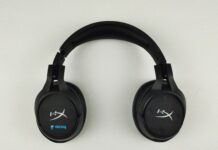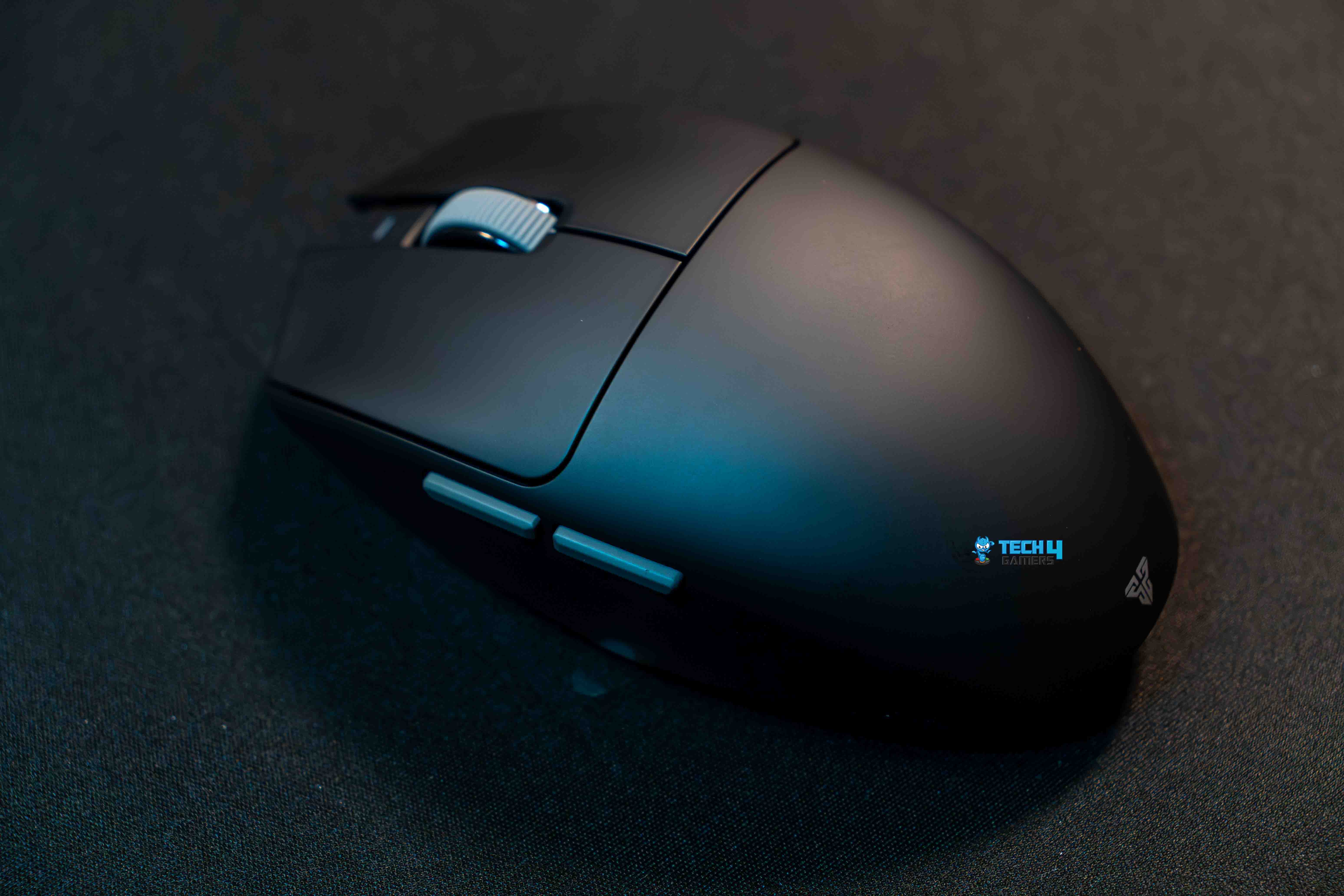A Great Choice!
Review Summary
The Aula F81 is the best transparent keyboard you can get, with even more potential if you choose to mod it. Its thocky sound and excellent build quality make it a standout, allowing many to look past its subjective aesthetics and appreciate a polished product. While it has some flaws, compared to similar keebs, it offers an unparalleled all-in-one package.
Hours Tested: 1 Week
Overall
-
Design - 8/10
8/10
-
Build Quality - 9/10
9/10
-
Typing - 7.5/10
7.5/10
-
Value - 7/10
7/10
Pros
- Excellent build quality.
- Well-lubed, consistent stock switches.
- Smooth RGB with plenty of effects.
- Great thocky sound profile.
- Solid battery life and wireless connectivity.
- Dedicated buttons for switching modes and platforms.
Cons
- Poor stabilizers with lots of rattle.
- Keycaps catch a lot of finger oils.
- Keycap legends might fade over time.
- Not easy to take apart; hard to mod.
The world of custom keyboards exploded a few years ago amidst the pandemic when everyone locked inside their homes was forced to find a new hobby. Building and modding your own keyboard provided a sense of accomplishment that transformed into a new market segment overnight. Companies realized that focusing on the enthusiast side of peripherals was not just a niche anymore.
Creating high-quality budget keyboards, therefore, became a rat race, with Aula emerging as one of the finest brands working right now. Today, I’ll be taking a look at their newest offering, the Aula F81. This is far from the company’s first foray into making transparent keyboards, but it’s certainly their most expensive one yet.
Key Takeaways
- Aula F81 is a gorgeous keyboard with plenty of lighting to turn even the coldest heads. Its combination of features makes it more versatile than other transparent boards on the market.
- Buy the Aula F81 if you value design, build quality, and the unboxing experience and want a keyboard that stands out in any setup.
- Avoid the Aula F81 if you can’t compromise on rattly stabilizers, prefer a cleaner look, and want to mod your keyboard easily.
Unboxing Experience
Out of the entire Aula lineup, the F81 is the most well-packaged, with a premium unboxing experience. The box art here is much more extravagant compared to the Aula F87 Pro and features an anime character upfront. The box itself is heavy and has no tabs, instead you simply lift the top to slide out the bottom like an Apple box.

Inside, you’re greeted by the keyboard with a plastic cover on top. The manual, an instructions card and a sticker sheet are also present right under some protective foam. Toward the side, you’ll find the accessories box, and once again, this is where the Aula F81 differentiates itself by including a few extra goodies.
The keyboard comes with:
- 1x Aula F81 Keyboard
- 1x User Manual
- 1x Instructions Card
- 1x Stickers Sheet
- 1x Keycap/Switch Puller
- 1x 2.4GHz USB Receiver
- 1x Coiled USB-C Cable
- 1x Microfiber Cloth
- 1x Cleaning Brush
- 1x Allen Key (with screws)
- 2x Metallic Decorative Pieces
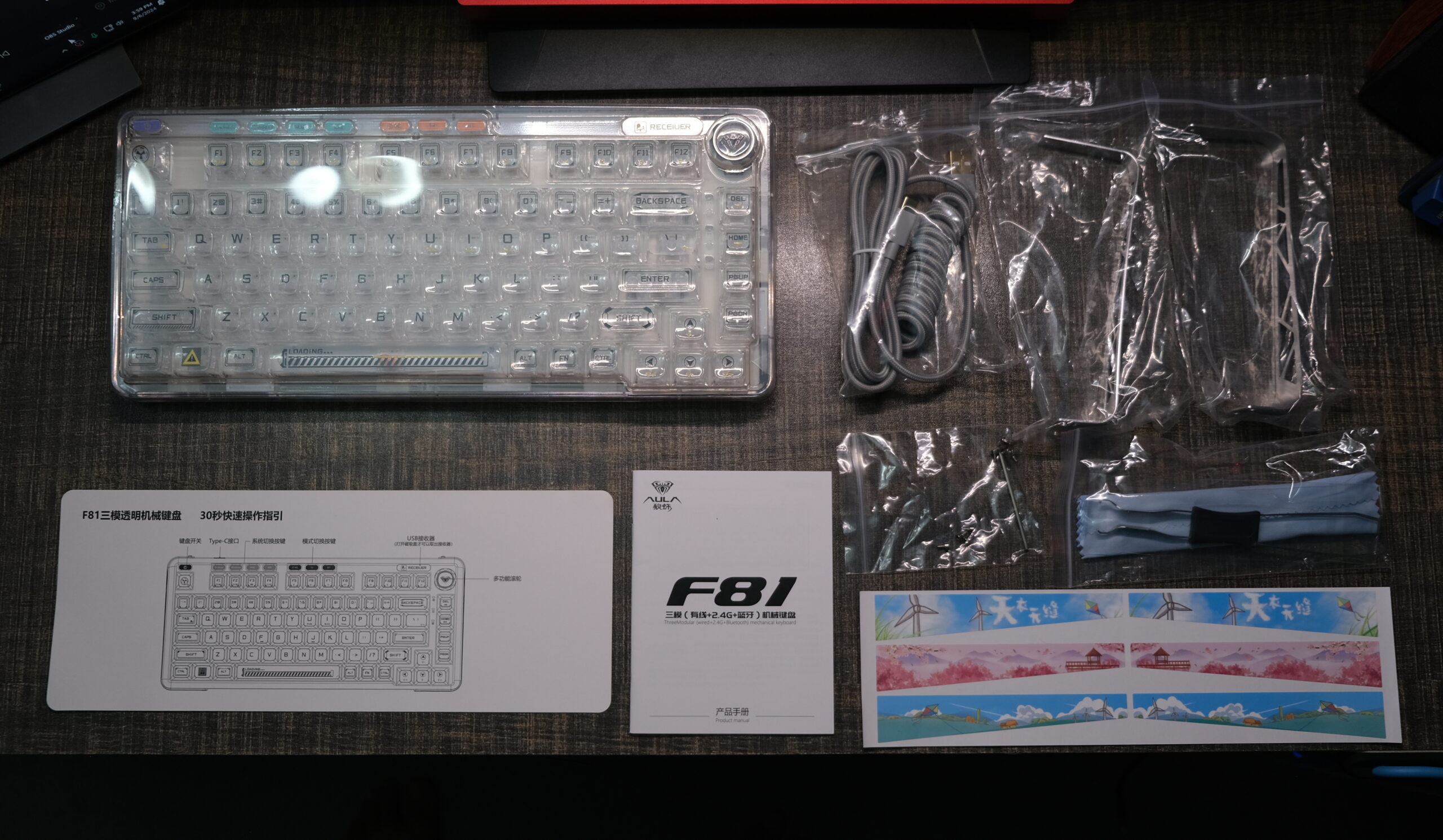
Design & Build
Aula F81 sports a 75% layout and a striking appearance that comes to life with RGB. The keyboard features a fully transparent case and polycarbonate keycaps that show a clear view of its inner layers. Positioned along the top bezel are eight buttons that control power, platform switching, and connection modes. All of them are clicky and backlit.
In the top-right corner, you’ll find a volume knob, and it’s one of the best I’ve ever used—offering an ultra-satisfying clicky rotation with no wobble. The knob’s outer ring feels metallic, while the plastic center has some kaleidoscope-like lighting that, unfortunately, cannot be customized. Next to it is a nifty magnetic holder for the 2.4GHz wireless receiver.
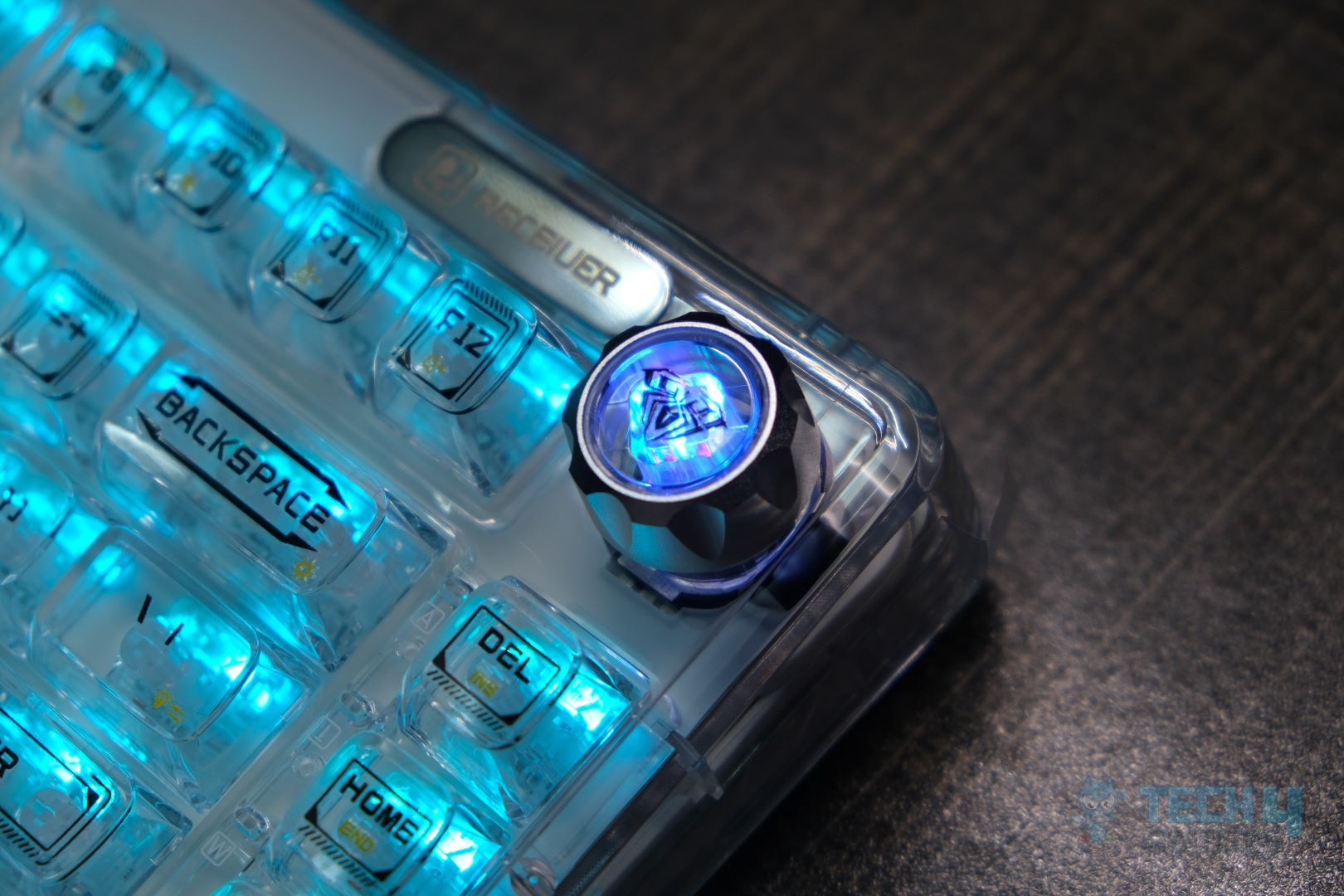
The back is clear as well, but the bottom case foam blocks any view inside. The board is also wrapped in plastic to protect it from scratches. In the middle, there’s a metal badge with some product info and flip-out feet on the left and right that have two stages. Most interestingly, the sides of the keyboard have space to screw in some metal decorative pieces that can be further customized with the provided stickers, but I didn’t really think any of them went well with the board’s overall look.
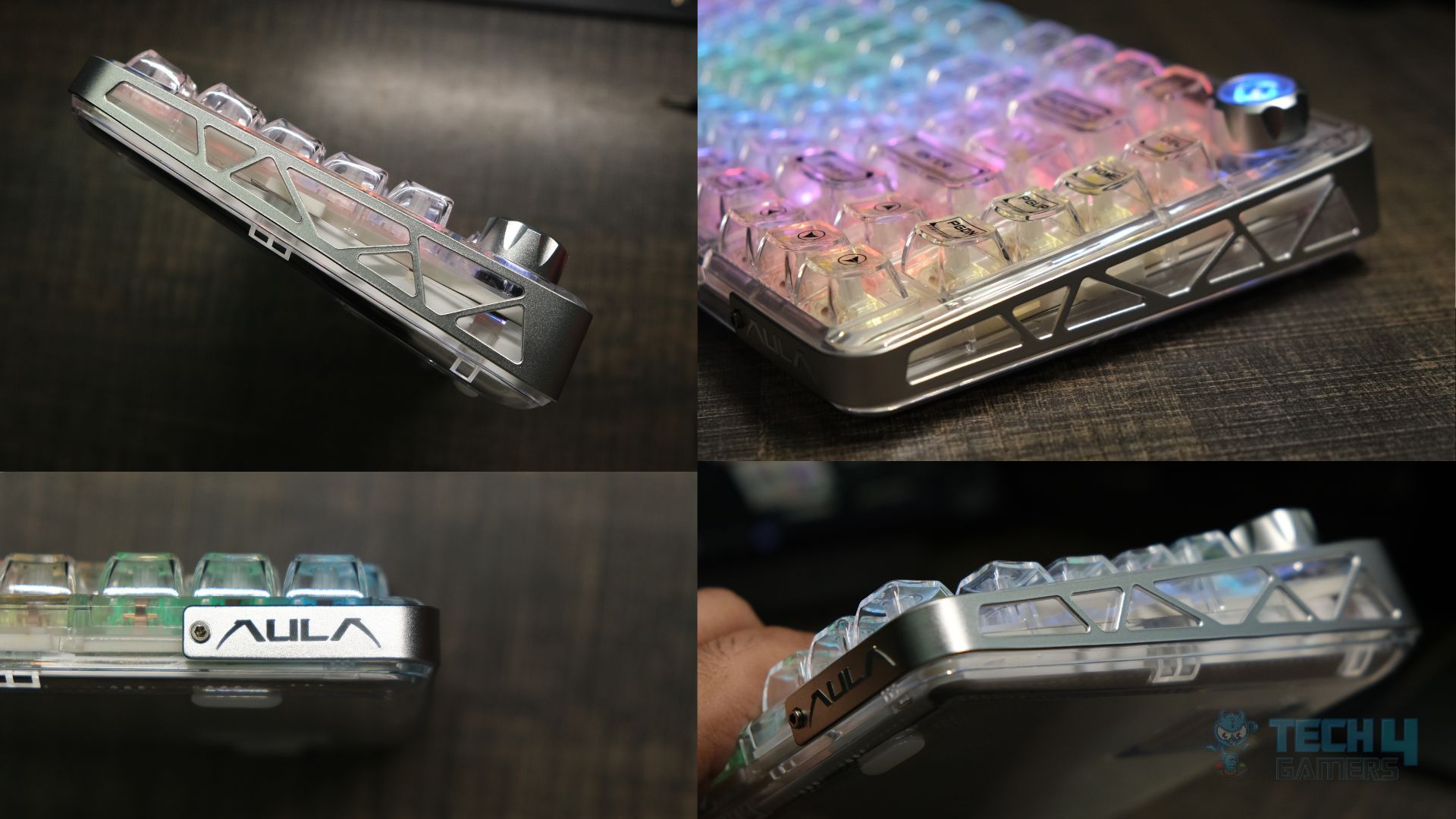
All that mixed with its futuristic legends, this keyboard is a bold departure from the safe, neutral color schemes of previous Aula boards. While see-through concepts are always welcome, making them glossy and fully transparent (rather than translucent) veers into tacky territory for me. That said, the look is highly subjective, and I can see it thriving in the right setup.
What I can’t deny is the thoughtful design. Despite weighing just shy of a kilo, the build quality throughout is excellent; there is no case of flex or creaking whatsoever. Aula fully commits to the glass-like look, and all the small details reflect the care and attention that went into its creation. For the right person, this will be a highly polished product.
RGB Galore
If human lives thrive on purpose, the Aula F81 thrives on RGB. It’s clear that lighting is a major part of this keyboard’s design—its fully transparent build makes that obvious. There are 21 built-in effects, which you can cycle through using Fn key shortcuts, and aside from two, all are very smooth, even at their slowest speed setting. You can also toggle between 4 brightness levels and 9 static colors. However, Aula doesn’t provide any dedicated software for precise customization.
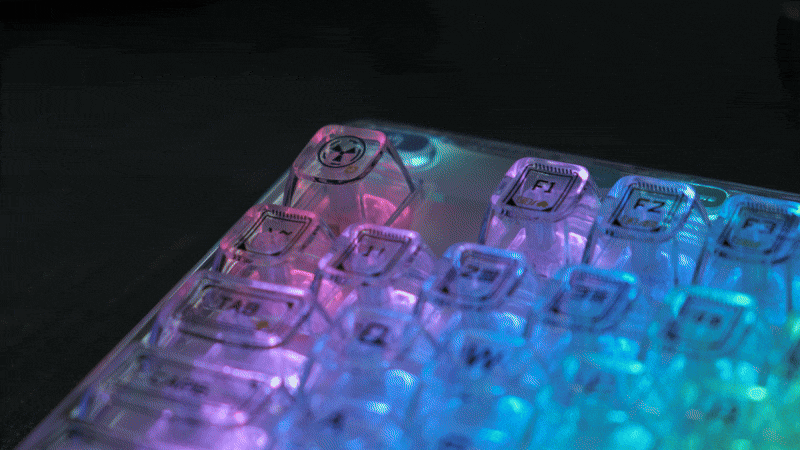
The Fundamentals
The Aula F81 is not meant to be taken apart, so the disassembly is quite difficult. I didn’t see any visible screws, which means the case is held together with tabs; forcing it too much can shatter the polycarbonate (unlike ABS or PBT). That’s why I couldn’t mod this keyboard and will only be judging it in its default configuration.
Switches
My unit of the Aula F81 is rocking the Ice Soul switches which are a factory-lubed tactile manufactured by Leobog. The spacebar features a different, much heavier switch that I could not find any info on. While I’m not a big fan of tactile switches, preferring the smooth travel of a linear, I’m pleased to report these are awesome stock switches regardless.
The initial 49g tactile force feels just heavy enough to provide a satisfying bump followed by a smooth 45g bottom out. If you like to “feel” what you’re pressing, you’ll have a great time with these. They have minimal stem wobble on par with other Leobog switches and they sit snuggly inside the PC plate. Upon opening up the switch, I found both the stem and spring inside is oiled properly and this lubing is consistent across the entire batch.
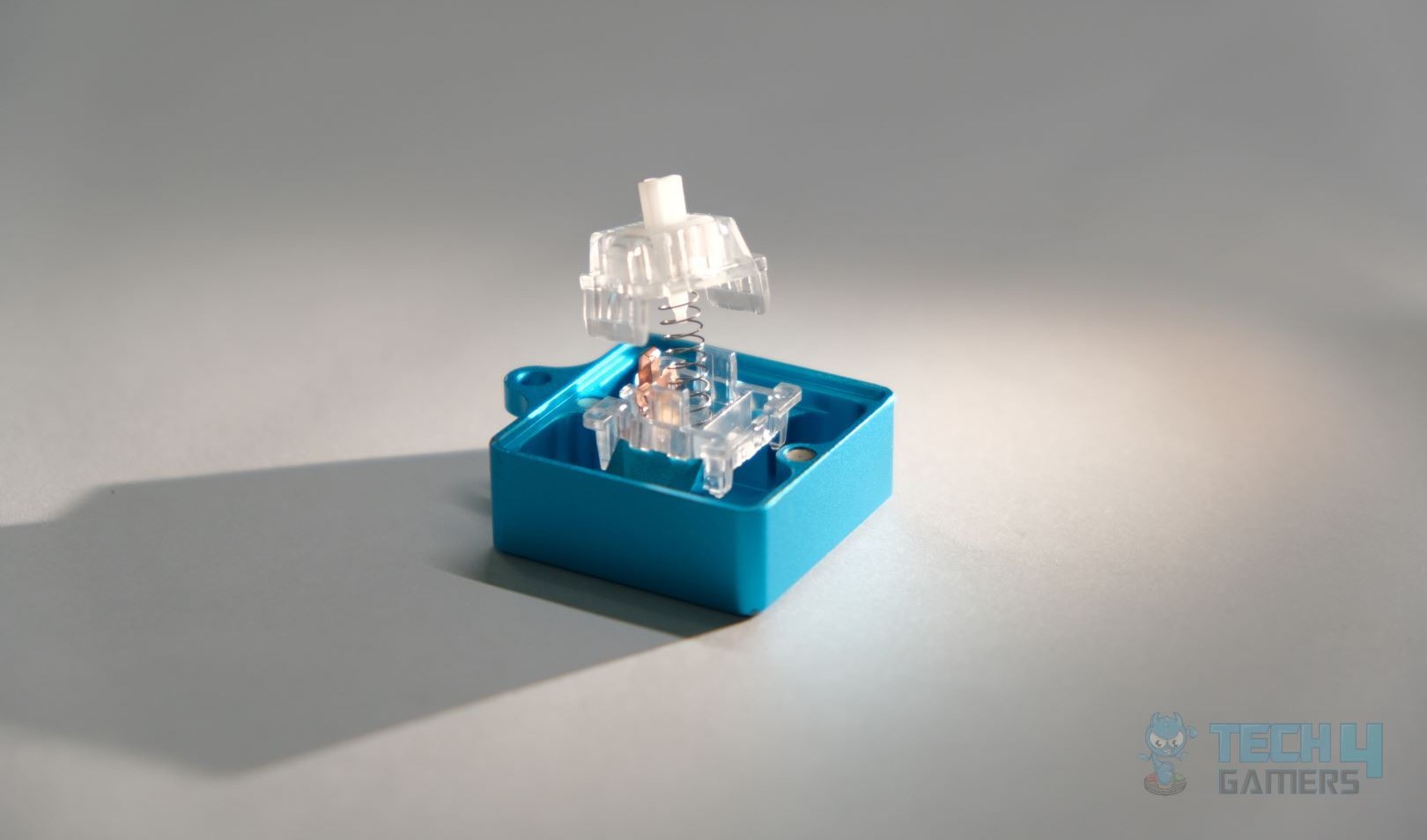
Overall, these switches have a low-pitched thocky sound that should be easy on the ears for everyone. That being said, the board is fully hotswap featuring north-facing 5-pin sockets. As such, I swapped the spacebar switch to an Akko Yellow linear and it sounded much nicer, but I still preferred the tactiles on the alphas.
Keycaps
Moving on, the keycaps here aren’t doubleshot or dye-sub; instead, they feature 3D-printed legends. I’m not a fan of the font, but the yellow sub-legends for secondary functions are quite helpful. Aula claims they’ve applied a special coating to prevent fading, but I find it hard to believe these will last long. The printing already lacks sharpness, and the coating seems like it’ll wear down over time. Their glossy finish also makes them prone to finger oils, and they might yellow quicker if your hands are oilier like mine
Aula is using a proprietary “GDA” profile that feels like a blend between SA and XDA. The keycaps cupped my fingers nicely and were very comfortable to type on. They’re as thick as most keycap sets and work well with the stock switches to produce a satisfying thock. I tested these keycaps on other boards and swapped different switches on this board, but none of the combinations felt as satisfying as Aula’s stock config.
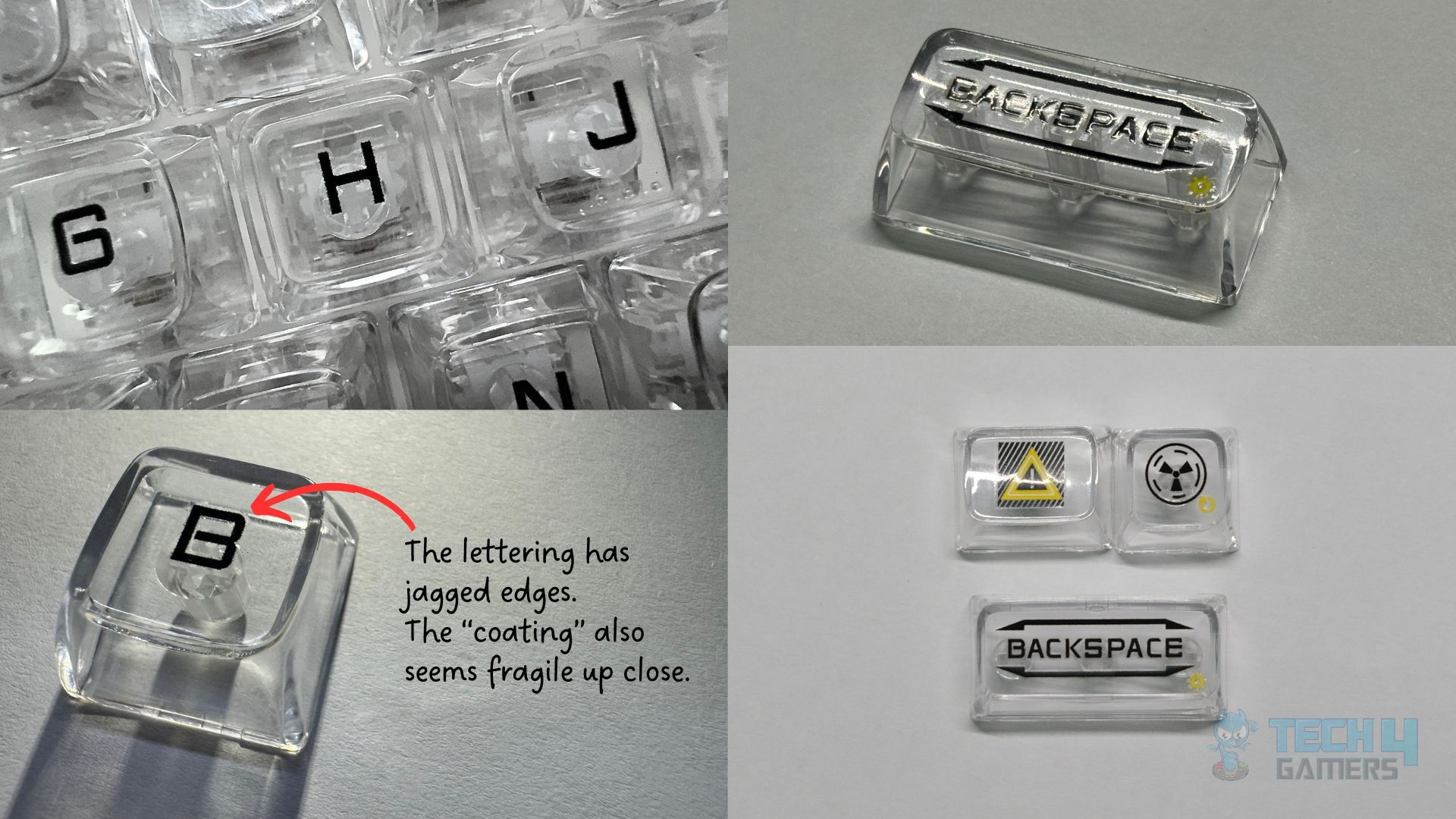
Stabilizers
Lastly, Aula F81 uses standard plate-mounted stabilizers that come pre-lubed from the factory, but they’re not great. All the stabilized keys in my unit exhibited some ticking or rattling, with the worst offender being the spacebar. The stabilizers here seem a generation older than other budget boards; they have a significant wobble on either side, which is just exacerbated by the keycaps.
Upon closer inspection, the stabilizers are both internally and externally affected. Inside, the stem sits very loosely in the stabilizer housing, and there’s not enough lube to fill in the gaps. From the outside, the stabilizer doesn’t fit tightly in the plate; I can easily wiggle them with minor force. The spacebar stab is also hard to take out because a PCB foam blocks out any space for the wire to come out of.
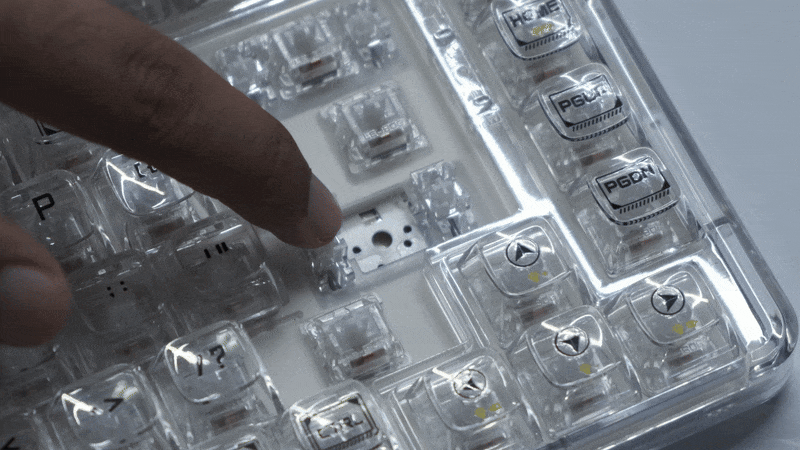
Performance & Battery Life
Aula F81 performs like any modern keyboard worth its name. It has a standard 1000hz polling rate with both wired and wireless connections. We experienced no lag using it wirelessly over 2.4GHz, but I’d still recommend plugging it in for competitive play. Over Bluetooth, the polling rate drops down to only 125Hz, but that’s a Bluetooth limitation, so it’s the same for any keyboard. Still, the typing experience on iOS and Android was without any issues.
As for the battery life, the 4000mAh cell lasted 18 hours with the RGB on. After filling it back up the next day, I used it moderately with all the lights turned off, and it’s been a week since I last charged this keyboard. It’s safe to say that battery life here is on par, if not better, than other industry-standard keyboards, including Aula’s own lineup. Charging it up is as easy as just plugging in the USB-C cable which means one less cable to worry about if you’re bringing this with you on the go.
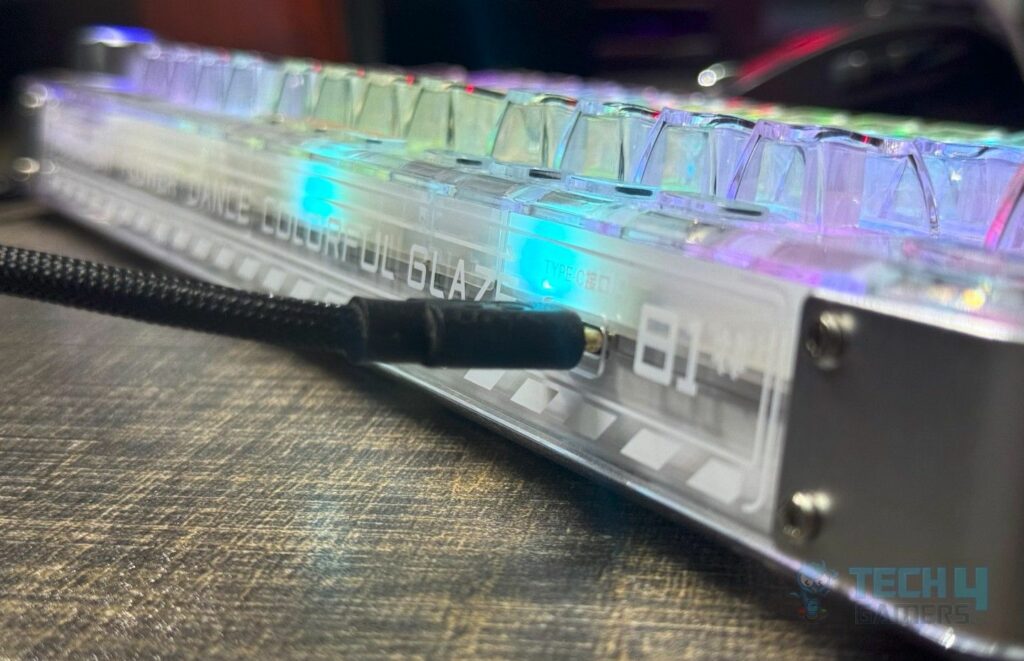
Typing Experience
Aula F81 is a gasket-mounted keyboard, and as such, it has some flex, but it’s only apparent when pressing hard on it. This board certainly does not have a bouncy typing feel, which is reminiscent of other Aula boards. In the grand scheme of things, using the Aula F81 is, as boring as it may sound, fine. To me, it’s a compromised experience because of the poor stabilizers. Every time my thumb would hit the spacebar, I’d be reminded of how it all could be better.
There’s plenty of foam inside the board to make any switch sound nice. I tried some HMX switches with Cherry profile keycaps, and they were a delight, mostly thanks to the included PE Foam sheet sitting right above the PCB. The bottom case foam also helps reduce hollowness and provide a “full” sound.
Overall, I’d say that for a first-time user, the shortcomings of the Aula F81 will certainly not be as noticeable. The flashy looks, genuinely impressive build quality and nice-sounding alphas would cover up the imperfect stabs and somewhat cheap-feeling keycaps. In fact, if you’re coming from a “gaming” keyboard, this would probably be a day and night difference for you.
What Makes the Aula F81 Different
Aula F81 is not the first of its kind neither will it be the last, but it does position itself as perhaps the first transparent keyboard with no glaring compromises. The Yunzi X75 is another option in this category but it’s not wireless, neither does the Attack Shark X75 or the Womier K75. Meanwhile, the KiiBoom Phantom 81 is almost double the price but south-facing sockets, which would actually be a turn off for a keyboard all about RGB. K75 If you can look past its rattly stabs, there is currently no other crystal as shiny as this one.
Should You Buy It?
Buy It If
✅ You like see-through designs: The shining highlight of the Aula F81 is its crystal-like design that comes to life with its bright RGB.
✅ You want a well-built keyboard: Aula F81 has a decent heft to it along with excellent build quality, making it a premium-feeling product.
✅ You value the extras: With some extra goodies included inside, the Aula F81 stands out from the rest with an amazing unboxing experience.
Don’t Buy It If
❌ You want good stabilizers: Aula F81 has poor stabilizers that have major issues such as stem wobble, insufficient lube, and loose fitting.
❌ You prefer an understated look: Consider the company’s other models, like the F75 and F87 Pro, for a more neutral color scheme.
❌ You need easy mod-ability: Due to Aula F81’s polycarb construction, the board is not easy to take apart and thus not suitable for modding.
My Thoughts
Aula F81 is by no means a bad keyboard but prioritizing design over the fundamentals, especially for your flagship product is never going to illicit a positive response. And with the Aula F75 already existing in the company’s lineup as another 75%, I’ll pick that 9 times out of 10, with the one exclusion being for the F81’s striking design.
All in all, if you’re after a specific, transparent look, then the Aula F81 is a great option with further potential should you choose to mod it. For me personally, the excellent build quality and thocky sound cannot make up for the lack of solid stock stabilizers, but if I’m in a pinch and the Aula F81 is the only keyboard I get to use, I’ll still have a good time looking at its light show. Heck, I’d probably just gut the thing and repurpose the parts elsewhere.
Community Poll
Thank you! Please share your positive feedback. 🔋
How could we improve this post? Please Help us. 😔
Born and raised around computers, Huzaifa is an avid gamer and a keyboard enthusiast. When he’s not solving the mysteries of technology, you can find him obsessing over semiconductors, striving to inform the curious.
He’s been modding tech since forever and knows a thing or two about what makes a great typing experience, making him the perfect expert to rely on for your keyboard recommendations! With his IT certification from Google, you can trust him to advise you with deliberation and integrity.
- Favorite Prebuilt: Epomaker P75
- Favorite Budget Option: Tecware Spectre 75
- Favorite Custom Keyboard: TKD Cycle7 / Lucky65 V2


 Threads
Threads
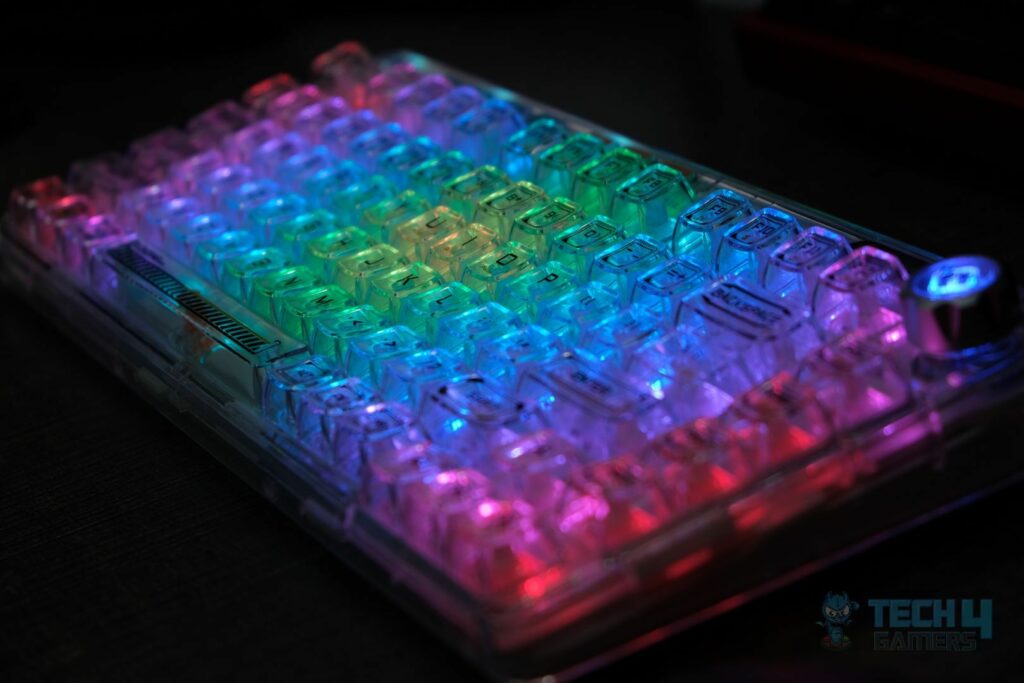
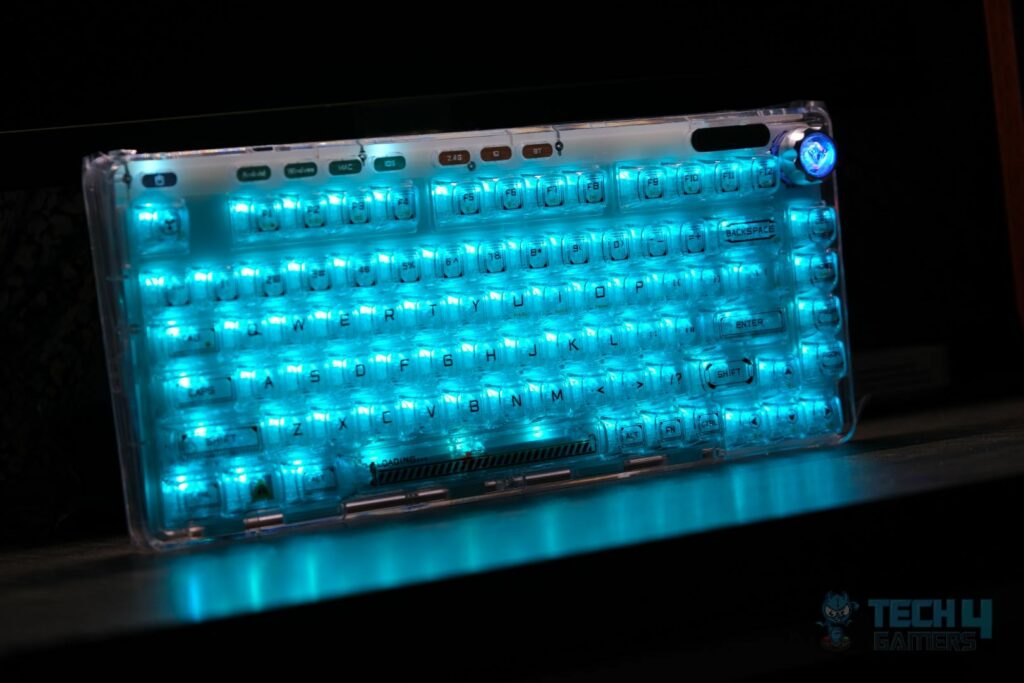
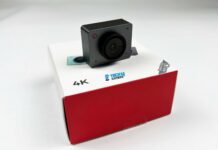
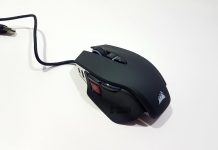
![Best Mouse For Butterfly Clicking [Hands-On Tested] Best Butterfly Clicking Mouse](https://tech4gamers.com/wp-content/uploads/2023/07/Best-Butterfly-Clicking-Mouse--218x150.jpg)
